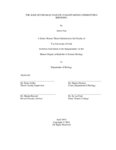TO
| Creator | Title | Description | Subject | Date | ||
|---|---|---|---|---|---|---|
| 76 |
 |
Skedros, Gregory Athanasios | Structural and material changes in the sheep radius from newborn to adult: Functional adaptation versus developmental constraint | Bones that exhibit marked changes in structural and material characteristics during ontogeny are potentially useful for studying the mechanisms that produce functional adaptations. The diaphyseal region of the sheep radius was examined because it is relatively simply loaded in cranial-caudal bending... | Functional adaptations - Sheep; Developmental constraint - Sheep; Ontogeny | 2015-08 |
| 77 |
 |
Enriquez, Trisha Pauline Diaz | Substrate use within the drosophila melanogaster species subgroup | Effective sensory perception is a vital aspect of survival for living organisms such as Drosophila. More specifically, olfaction, or the sense of smell, is essential because the detection of odors allows it to find potential food, danger, or specifically, where to lay eggs. This review will examine ... | 2021 | |
| 78 |
 |
Watkins, Ryan Davis | Suppression of lymphangiogenesis using VEGF-C trap | The lymphatic system is responsible for controlling systemic fluid buildup. Lymphangiogenesis is a dynamic process involving sprouting, and maintaining new lymphatic vasculature. Vascular endothelial growth factor C (VEGF-C) is as a key growth factor that induces lymphangiogenesis by binding VEGF re... | Lymphatics - Growth; Vascular endothelial growth factors - Antagonists; Lymphangiogenesis; VEGF-C trap | 2014-05 |
| 79 |
 |
Domagala, Drue | Synthesis of protacs to inhibit toll-like receptors | The immune system is the body's defense against pathogens. Since it has to be able to withstand the fast-evolving nature of microscopic invaders, the immune system has a variety of mechanisms to recognize and destroy them. One way that pathogens are recognized is through toll-like receptor (TLR) sig... | 2022 | |
| 80 |
 |
Judd, David Paul | Telomere proteins of Drosophila melanogaster: HipHop and MSK81 | DNA molecules encoding two proteins, HipHop and MSK81, were cloned into bacteria so as to make large amounts of these proteins that bind to telomeres of Drosophila (fruit fly) chromosomes. The goal was to determine whether known DNA binding motifs are present in HipHop and MSK81. Understanding how t... | Biology | 2012-05 |
| 81 |
 |
Roestenburg, Jessica | Testing the Perceptual Salience of Spectral Content in Zebra Finch Song | Birds actively adjust the resonance properties of the upper vocal tract during singing, which results in specific harmonic structures of song elements. To what degree upper vocal tract filtering is relevant for the perceptual salience of song is poorly understood. This research utilizes (1) a biolog... | 2018 | |
| 82 |
 |
Gardner, Jenna | The Disparity Between Student Science Writing and Professional Sciencetific Writing | There exists a disparity between student scientific writing and professional scientific writing. The audience, format, and intention of student papers as presented in the science classroom is different from those in the scientific field where the goal is to fully convince an unfamiliar audience and ... | 2017 | |
| 83 |
 |
Curtis, Kaili Breann | The Effect of Inflammatory Components on Influenza a Virulence Evolution | The methodology for passaging influenza A virus in the mouse model has widely been established. However, traditional infection methods involving the inoculation of lung homogenates fail to account for the possible effects of host-associated factors on measures of virulence and in the virulence evolu... | 2020 | |
| 84 |
 |
Thomas, Nathaniel | The HIV-protective bystander effect in macrophages is viral glycoprotein dependent and likely conferred via upregulation of ISG IFITM3 | During an immune response against a specific antigen, often during viral infections, T cells not specific to the antigen can be activated, a phenomenon known as bystander response. The "bystander response" has been studied extensively in T cells, but when examined for macrophages through the lens of... | 2022 | |
| 85 |
 |
Bader, Cecily | The Response of Arabidopsis Mutant BPS1-2 on Salt Media | How would our world change if salt tolerance could be engineered in plants? The Arabidopsis mutant bps1-2 has been shown to respond differently on salt media than a nonmutated plant would. In normal conditions, the bps1-2 mutant will arrest development in the root and shoot shortly after germination... | 2017 | |
| 86 |
 |
Russell, Nicole | The Role of Introns Within Alpha Conotoxin Genes in Cone Snails | Cone snails, of which there are more than 600 species, have attracted a lot of attention. Cone snails, found in warm tropical waters across the world, are predators and produce venoms comprising diverse toxins. These toxins, termed conotoxins, have been the subject of a great amount of research. Whi... | 2016 | |
| 87 |
 |
Kannan, Sarmishta Diraviam | The Role that Lysosomes and Autophagy play in Alveolar soft parts Sarcoma, clear cell Sarcoma and Synovial Sarcoma | Sarcomas are cancer of the connective tissue and are very deadly group of cancers. Two of the sarcoma types, alveolar soft parts sarcoma (ASPS) and clear cell sarcoma (CCS) have a unique vacuolar morphology. This unique morphology is absent in synovial sarcoma (SS). We believe that the unusual morph... | 2017 | |
| 88 |
 |
Yang, Kevin | The Soluble (PRO) Renin Receptor does not Influence Lithium-Induced Diabetes Insipidus but does Provoke Beigning of White Adipose Tissue in Mice | Earlier we reported that the recombinant soluble (pro) renin receptor sPRR-His upregulates renal aquoporin-2 (AQP2) expression, and attenuates polyuria associated with nephrogenic diabetes insipidus (NDI) induced by vasopressin type 2 receptor (V2R) antagonism. Patients that receive lithium therapy ... | ||
| 89 |
 |
Bell, Anthony W. | The expansion of pinyon-juniper woodland and the appearance of peromyscus truel in the Toiyabe range of central Nevada | In the early twentieth century field biologists from the University of California Museum of Vertebrate Zoology conducted vertebrate faunal surveys throughout the Great Basin region. Over the past several years we have been conducting resurveys of many of the localities visited by MVZ scientists. Our... | Piñon mouse -- Nevada -- Toiyabe Range; Piñon mouse -- Habitat -- Nevada -- Toiyabe Range; Piñon mouse -- Climatic factors -- Nevada -- Toiyabe Range | 2012-05 |
| 90 |
 |
Pham, John V. | The function of the protein VCP/CDC48-associated mitochondrial stress-responsive 1 in mammals | Although mitochondrial dysfunction has been linked to many human diseases, mitochondrial interacting proteins and protein quality controls are just beginning to be understood. The objective of our study was to characterize the function of the VMS1 protein in mammals. We determined the role of Vms1 o... | Mitochondrial disorders; Mitochondrial diseases - genetics; VMS1 | 2012-05 |
| 91 |
 |
Excell, Katerina | The role of amyloid precursor protein in a model of alzheimer's disease | Alzheimer's disease (AD) is a devastating disorder that leads to deterioration of cognition and memory. The prevalence of AD dramatically rises with age, and is also much greater in individuals with trisomy 21 (Down syndrome, DS). Many gene products are overexpressed in DS by virtue of having three ... | 2022 | |
| 92 |
 |
Nau, Adam | The role of heparan sulfate in maintaining stereotyped birdsong | Song learning in Zebra Finches (Taeniopygia guttata) occurs during a critical period between 30-90 post hatch days, and involves acquisition of an acoustic model and a sensorimotor period of increasingly improving imitation of this model. Young birds sing highly variable songs early during this pe... | Birdsongs - Research; Zebra finch - Research; Songbirds - Behavior; Heparan sulfate; Taeniopygia guttata; Neural circuitry | 2016-04 |
| 93 |
 |
Wang, Zhirong | The role of the autism-associated gene kirrel3 in synapse formation | Alterations in the gene Kirrel3 are repeatedly associated with intellectual disability and autism. Kirrel3 regulates synapse formation in C. elegans but the role of Kirrel3 in synapse formation in the mammalian brain is unknown. In mice, Kirrel3 is expressed in specific cell types throughout the bra... | Autism -- Genetic aspects; Synapses; Kirrel3 gene; Synapse formation | 2015-04 |
| 94 |
 |
Rowe, Ana Bruns | The suppression of signal-switching defects in the Escherichia coli serine chemoreceptor | The model bacterium Escherichia coli contains a chemotaxis system that allows the cell to change its swimming behavior in response to its environment. As the cell swims, transmembrane chemoreceptors detect concentration changes in attractant and repellent compounds and transmit signals across the in... | 2023 | |
| 95 |
 |
Woodruff, Derek | Uncovering Synaptic Defects resulting from loss of the intellectual disability and autism-associated gene Kirrel3 | Neurodevelopmental disorders severely impact an individual's life. Surprisingly, the genetic and cellular cause of over half of intellectual disability cases and more than 80% of autism spectrum disorders remain undiscovered1,2. It is likely that mutations in molecules regulating synapse development... | 2017 | |
| 96 |
 |
Amaechi, Ayana | Understanding sex differences in early predictors of pathological aggression with a mouse model | Antisocial behavior (ASB) is characterized by aggression, violence, drug use, thrillseeking behavior, and delinquent behavior. While childhood and adolescent maltreatment contribute to the ontogeny of this condition, converging evidence suggests that genetic factors play an equally important role. T... | MAOA; pathological aggression; sex differences; stress; early development; animal models | 2021 |
| 97 |
 |
Lee, Zachary | Using Drosophila to investigate p53 life-or-death decisions | The p53 tumor suppressor is a central regulator of cellular responses to DNA damage. When DNA damage cannot be repaired most cells undergo p53-dependent cell death. Thisp55-mediated apoptosis is important to eliminate cells with damaged genomes and provides an important block to the development of c... | Biology | 2013-05 |
| 98 |
 |
Som, Sarita | Virus-like weapons used for competition in wild plant populations | Plant diseases caused by bacterial pathogens pose significant economic challenges globally, necessitating the exploration of alternative methods for controlling bacterial infections in plants. Tailocins, virus-like weapons produced by bacteria, have emerged as potent antibacterial agents and hold po... | 2023 | |
| 99 |
 |
Checketts, Cynthia | Why white mice? improving biological literacy through animal history | Throughout the undergraduate experience, biology students are introduced to hundreds of experiments, theories, and principles, many of which are rooted in animal experimentation. However, in required and information-heavy biology courses, the erasure of animals from the scientific story-which repres... | 2021 |
